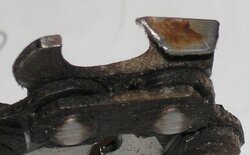Bill
Minister of Fire
Don't want to hijack the thread but I cut down a stump, and I know it had sand in it. But anyhow I knocked the chain off and it hit that metal guard and stopped. It's a Husky 455. I have the two file Husky sharpener and I sharpened it twice and it still only shoots small chips. There doesn't seem to be any damage. I am very careful with the angle I sharpen at. The saw is very new, so the bar and chain are also. Not sure what my problem is.




 . I was cutting a dead elm that fell across my parents driveway. One side of the tree had some snow on it from the driveway. ALSO in that snow was some gravel from the driveway...whoduh thunk (the worst part....i looked for gravel, didn't see any but to be on the safe side I knocked off "most" of the snow. Apparently not enough).
. I was cutting a dead elm that fell across my parents driveway. One side of the tree had some snow on it from the driveway. ALSO in that snow was some gravel from the driveway...whoduh thunk (the worst part....i looked for gravel, didn't see any but to be on the safe side I knocked off "most" of the snow. Apparently not enough).